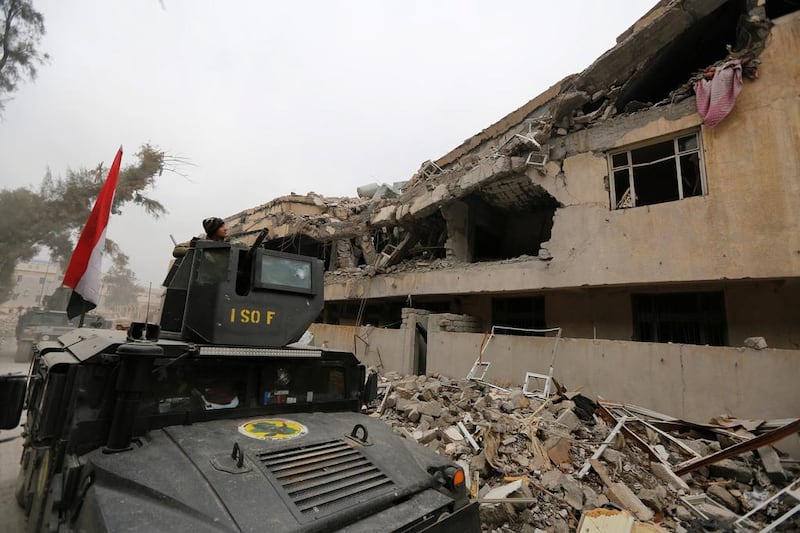MOSUL, IRAQ // The bomb comes down with a shrill whistle and explodes just metres from the Mosul university campus, piercing an eerie silence only punctuated by the sounds of battle echoing from the streets nearby.
A brief ball of fire flashes briefly before a plume of smoke rises from behind the cluster of beige buildings. Another coalition air strike has found its mark.
Not one of the structures that housed the faculty, administration and students has been left unscathed by the battle to expel ISIL. Air strikes have sheared off roofs and collapsed entire floors, fire has gutted interiors and blackened facades, broken glass and other debris litter the courtyards. Iraq’s second largest university is now lifeless.
The contest for the university has been another fierce engagement in the three-month-long campaign to liberate Mosul.
“It was a tough fight because this is Daesh’s last defence before the river. The fighting was heaviest in the final buildings we took,” says Sergeant Dafour, one of the soldiers securing the campus. He says the Iraqi Special Operations Forces and coalition air strikes killed 43 enemy fighters during the two-day battle.
Twelve ISIL fighters were taken prisoner, among them two Russian snipers, according to Sgt Maytham of the ISOF, who also took part in the battle.
Iraqi special forces wrested control of the campus from ISIL on Saturday, further reducing the insurgents’ hold over eastern Mosul. But on Sunday, the fight continued at the foot of the slope separating the complex from the few neighbourhoods still under ISIL control on the east bank of the Tigris.
In a building at the edge of the compound, soldiers on the first floor keep a wary eye on a house less than 100 metres away. An ISIL flag flutters on its roof and they had been shot at only a few minutes earlier. One soldier lifts his machine gun on to the window sill and pulls the trigger, sending the ammunition belt racing through the chamber as the muzzle spits fire. Next to him, another soldier empties the clip of his assault rifle.
In the spacious rooms of the first floor, medical equipment and books are scattered about in the half dark. Desks are still laden with documents, and furniture is stacked against windows to reduce visibility to enemy snipers. Movement through the campus is only possibe by staying behind cover, crossing open spaces in a sprint.
The Iraqi Special Operations Forces that took the university a day earlier are still out in force, groups of soldiers stationed all along its fringes. The elite outfit’s trademark black Humvees are parked on the leafy road through the campus, their crews warming themselves next to fires with rifles by their side.
The Iraqi troops had to deal with a now familiar threat, as ISIL sent suicide car bombs at them when they entered the campus in their Humvees. More than 10 car bombs had to be dispatched, or were detonated by the defenders before reaching thei targets, Sgt Maytham says.
In the residential neighbourhoods of eastern Mosul, the ISOF often had to fight with little air support for fear of civilian casualties. But at the university, the advancing troops could call in help from above.
“Because there are no civilian houses here, there were more air strikes. That helped us a lot,” Sgt Maytham says.
ISIL occupied the campus after taking control of Mosul in June 2014. It soon turned the university into a base, and its research laboratories into a production site for chemical weapons. The coalition bombed the campus repeatedly before the campaign to liberate Mosul began in October.
The air strikes did not prevent the extremists from continuing their quest for weapons of mass destruction at the university, according to Sgt Maytham.
“We found a chemical weapons factory here yesterday. All the equipment was still there. The engineers came and took some things away to investigate them more closely,” he said.
The capture of the university is another victory in an advance that has quickened since the beginning of the year. Iraqi forces have adapted their tactics to counter the motorised suicide attacks, and more troops have been deployed to the east bank.
The ISOF advance from the east is now supported by fresh units from the south-east, and by an army division from the north. The US has increased its support by sending in more special forces and advisers, who often accompany the Iraqi forces deep into Mosul.
As a result, the battle for the city’s east bank is drawing to a close. West Mosul, with about 60 per cent of the city’s remaining inhabitants and most of its main government buildings, is still under ISIL control.
Mosul university will not be the last ravaged landmark in the campaign to liberate the city from extremist rule.
foreign.desk@thenational.ae





